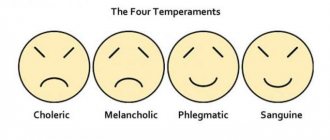The spiritual component of man
If science can say something significant and concrete regarding the material part of a person, then the spiritual component is closed to science - it cannot be measured by any instruments. The material essence of a person can be understood and science, by studying the genome, is increasingly convinced of how complex the human body is. And although many questions still remain, a lot can be understood here with the help of modern instruments and super-powerful microscopes. But if you look at the spiritual part, at what is often called the “soul,” then even more questions arise here.
Take, for example, such a question as a person’s sleep. Why do all people dream? If sleep is simply a product of human activity, a continuation of daytime experiences, then why does a person often find himself in places in his sleep that he has never seen? Why did D. Mendeleev see a table of elements in a dream, and the correct table at that? And here, involuntarily, philosophers begin to approach what they called the subconscious.
Key Differences Between the Conscious and Subconscious Parts of the Brain
Imagine: you actually have two brains! The conscious part that we all know about. It is with her that we usually associate ourselves. When we think about thinking, this is often what we have in mind.
But there is also a subconscious part that we simply do not notice most of the time. And just like subatomic particles, which behave very differently from atoms, molecules and other larger structures, the behavior of our subconscious is fundamentally different from the behavior of the conscious part. Let's look at how this happens and what role it plays in your effectiveness. […]
The subconscious is physically larger than consciousness
An amazing fact about the brain: it is made up of approximately one hundred billion nerve cells. This in itself is a fantastic number, but the real shock comes when you think about how all these neurons are connected to each other.
The connections from one nerve cell to another are called neural pathways, and this is where the real work happens. Each neural pathway corresponds to a mental or behavioral pattern. If you want to calculate how many neural pathways you have, let me help you: it would be 100,000,000,000 to the power of 100,000,000,000, which would give us a one with so many zeros that it would take four years to write them all down . With the same success this number can be called infinity. But here's the most important thing: there are a million times more neural pathways involved in the work of your subconscious than those involved in conscious activity. Thus, for every conscious thought and every action you have, there are a huge number of those that you are not even aware of.
And it is this unconscious part that will help you achieve the desired results.
Vincent Possente's book The Ant and the Elephant had a huge impact on our company and clients. We highly recommend you read it: it's great and yet very simple. But even our brief retelling will make it possible to understand how different the conscious and subconscious mind are, so we offer it below.
The plot begins with meeting Ant. He's very unhappy: constantly working, never making enough, barely making ends meet - I think you get the idea. Typical "life of an ant", isn't it? But Ant is constantly haunted by the feeling that somewhere there is a much more interesting and rich life for which he was born, but which he cannot achieve.
The Owl appears. The wise old Owl hears the Ant's lament about his life and hoots, “Hello, buddy! You seem a little upset.”
Ant: “yes!... I’m really upset. I work hard all the time, barely make ends meet, but I feel like I was born for something more.”
Owl: “Because you were born for more! And imagine, you can achieve all this and get everything you want, but first you have to get to the Oasis.”
Ant: “Oasis? I thought these were just fairy tales... Does he really exist?
Owl: “It definitely exists. And you need to get there. But what's even better: you can get there, it's not that far away at all. The oasis is due east from here.”
Ant: “Great! How do I get there? Can we go now?"
Owl: “You see, Ant... there is one problem. Of course, you can’t see it, but you live on the back of an Elephant. And this Elephant is currently heading west. you can go-go-go as long as you like, but until the Elephant on which you live turns, you won’t get there.”
As you probably already guessed, this fairy tale exactly describes the relationship between your conscious mind (Ant) and your subconscious mind (Elephant). For those, like us, who are confused by the words “billion to the billionth power,” the animal metaphor can make things easier to understand.
The real reason we sometimes feel like we're working hard but getting nowhere is because we're trying to get the Ant to do the Elephant's job!
Now, before you think, “Damn, I think I’m in trouble. My Elephant is definitely moving in the wrong direction, so I will never reach the Oasis,” wait a second. You can absolutely get there, you just need to figure out how to talk to your Elephant. When you learn to negotiate with your subconscious mind, you will be able to take a huge step in the right direction, and guess what will happen then?
Failures will practically cease to exist for you. If you get the Elephant to move in the right direction, the Ant can screw up almost everything else - but you'll still end up in the Oasis. […]
Your Elephant literally speaks a different language than your Ant, and you need to learn both languages
Your consciousness operates in the realm of logic, causality, evaluation and decision making. It understands the concept of time, knows consequences, and understands “if...then” constructs. Your subconscious is initially based on different principles. These two parts of your brain literally speak different languages.
It is important to understand how different these languages are. You know that some languages are so similar that if you speak one of them, you can at least understand the other? For example, if you know French, this will give you a good head start in learning and understanding Italian and Spanish. The language barrier between the two parts of your brain is completely different. It's more like the difference between French and German. They differ in literally everything: vocabulary, grammar, sentence construction - everything! If you speak French and think that this will make you good at German, this assumption will be completely wrong and will make you look like an idiot. Yes, France and Germany are located next to each other on the map, but their languages seem to come from different planets. And if you think that understanding one language will help you understand the second, then you may run into a problem, right?
The same is true with the tongues of your Ant and Elephant. If you speak Ant well, you will be good at Ant tasks:
- intellectual,
- requiring erudition,
- logical,
- manageable.
In addition, you will be excellent at a million other tasks that we are accustomed to highly value in the business world. Let me emphasize that these are all certainly positive characteristics (especially as a basis for success), but they are not the tools necessary to make a quantum leap, or achieve a goal without effort. This can only be achieved by letting go of the situation and immersing yourself in:
- intuition,
- flair,
- creation,
- innate sense of time.
All these elements of success live in your subconscious. This is solely the competence of your Elephant. Therefore, if you want to achieve a quantum leap, a breakthrough and find more elegant ways to achieve results, then pay special attention to this:
The language your subconscious mind speaks is the language of images.
The Power of Mental Imagery
Your subconscious—that same huge Elephant that is responsible for moving forward—thinks exclusively in images. Unlike the conscious mind, which uses words, thoughts and logical connections, the subconscious mind is completely visual and emotional. Basically, here's the best way to understand what the subconscious mind does: your subconscious Elephant simply sees a goal and goes towards it. This is all.
The subconscious is powerful, strong and very fast, but it does not know how to evaluate. When the picture forms the image of a destination, the subconscious mind does not decide whether this place is good or not. It's just heading there.
And here's what it looks like from your behavior: the subconscious sees a picture and makes you behave as if it is real... Even if it is not.
You may have heard that your mind is unable to distinguish reality from a vividly imagined image - and this is true, especially for your subconscious mind. If you can imagine something vividly and believably enough, your Elephant will accept it as the truth and make you behave as if it were reality.
There is a fairly well-known example of this phenomenon that many coaches have addressed over the past couple of decades. Try the experiment yourself while you read this...
The Reality of a Fake Lemon
Imagine the lemon as vividly and in detail as you can. Do you see him? Bright yellow, glossy, oblong. Great. Now mentally cut the lemon in half. Look at it inside. Do you see these segments and seeds? Great job.
Now bring the lemon to your nose and smell it. Did you smell that fresh, clean lemon scent? Fine. Now open your mouth, bring the lemon to it and bite it...
Stop for a second and notice how your body behaves. Right now, as you read this, we're willing to bet your mouth is watering, your jaw is a little tight, your face and shoulders are tense, and you're probably even wincing. Did you guess it?
This silly little exercise is a great illustration of the interaction between your conscious and subconscious mind. You brought up the mental image of a lemon absolutely consciously and intentionally - for this you involved the Ant. And once this image became clear and distinct enough, your subconscious Elephant (which controls all the automatic reactions of your body without attracting your conscious attention) came into play and caused your body to react as if this lemon was actually in your mouth. This is strange, we know, but the consequences of this go much further.
Take time to visualize your goal
[…]…why it is so critically important to learn to visualize your goal clearly and clearly. Simply allowing your inner Elephant to see the mental image of what you want to achieve will greatly increase your chances of success.
The best athletes in the world use these techniques all the time. If you watch golfers, basketball players, gymnasts, figure skaters or runners, you will notice that they always visualize the desired result before they manage to achieve it. This is one of the best examples of the “slow down to speed up” principle. Right before a performance, the best athletes don't just slow down; they stop completely and focus on creating an accurate mental image of the desired result. They visualize it. And then the subconscious absorbs this picture and makes it real.
So it's no coincidence that the best salespeople, business people, and great leaders use the same technique. Before achieving a result, they imagine it in detail
Before they begin a new week, day, meeting, presentation, or any other event in which success depends on their actions, they take time to stop and clearly see in their mind's eye the desired outcome. And then the subconscious itself will help them find the most elegant way to achieve it.
Is there a difference between the subconscious and the unconscious?
When studying philosophy and psychology, you can often come across words such as “subconscious” and “unconscious subconscious”. Upon deeper study, you will notice that these expressions are often found among authors who belong to different psychological schools. In some cases they are the same, and in others they are completely different.
Today, the human psyche is often divided into three components:
- consciousness;
- subconscious;
- unconscious.
Sometimes some philosophers add a fourth part - superconsciousness, but others attribute this closer to science fiction, since none of them have yet been able to prove that superconsciousness exists. Perhaps one could name God as superconsciousness, but this no longer relates to the personality of the person himself.
Today, both psychologists and philosophers have already decided on the human consciousness and there are no secrets or mysteries here. For the first time such a word as “unconscious” was used by Sigmund Freud and he associated it with the subconscious, since he did not like the word “subconscious”. But when reading S. Freud’s books, one can become even more confused, since he often used other words - “near-conscious”, “intra-conscious”.
If you take a textbook on physiology, you can read that along with consciousness, unconscious processes of information processing also participate in the activity of the brain of any person. And such processes can be classified as the unconscious, which includes three groups of phenomena:
- Preconscious - this can be attributed to the biological needs of the body, which are realized with the help of reflexes and instincts.
- The subconscious is something that was previously conscious and someday, under certain conditions, can become conscious again; This includes automated skills and behavioral stereotypes.
- Superconsciousness - often called intuition; in most cases it relates to creative processes that are no longer controlled by consciousness and leads to hypotheses and discoveries.
This conclusion is given by a textbook on physiology and according to it it turns out that the subconscious is one of the phenomena of the unconscious. But is it really that simple? Or maybe the unconscious retains information about a person’s past lives? Perhaps the Eastern religion is right, which teaches that every person is an eternal being and simply undergoes a process of rebirth, incarnation into a new body and a new image?
Does the subconscious exist? Unconscious? What is the difference?
Let me paraphrase the next answer, in which I like a lot, but also don’t like a lot.
The unconscious is what happens in your head without the participation of your consciousness. An unconscious part of the brain's daily functioning. Automatisms, in the broad sense of the word. In particular, you don’t think about how to breathe, or which foot to take the first step, or what to do to go to the toilet. You perform such actions unconsciously. At the same time, consciousness, of course, can take control of many things, but it is often pointless to get too involved in this: long-practiced actions will be performed slowly, clumsily, and you will not have enough attention for more relevant activities. If you want to conduct an experiment, try taking control of your breathing. Those. Control every breath and exhalation mentally: duration, intensity, pauses. If you are a stubborn person and you don’t get tired of it quickly, then over time you will notice that you cannot do anything else at the same time: all your attention will be concentrated on controlling your breathing, and attempts to do something else will be doomed to failure. Attention, which is the basis of consciousness, is a very limited resource of the brain. However, the brain does a lot without the participation of attention, in other words, without the participation of consciousness, unconsciously, and can learn to do something new in the same way: almost any skill can be trained to automatism, that is, learn to perform with less control of consciousness, or even completely unconsciously. In addition to motor skills, a huge number of auxiliary mechanisms work unconsciously in the brain, ranging from recognizing sounds and images to assessing what is happening around as scary, dangerous, interesting, valuable, etc. It is completely impossible to take much of the unconscious under the control of consciousness. A lot of things are just very difficult. Not everything that happens in the head and body can be paid attention to, without instruments one can notice the processes taking place, much less intervene in them. But the practices of concentration and looking into oneself—meditation on internal processes—still allow one to somewhat expand the areas available to attention and control.
And the subconscious is an unfortunate way to call the same thing. Unsuccessful - because it makes you think that there is some kind of second consciousness, like a hidden one, which also thinks something like that, and often not what the person thinks to himself. This is a very harmful illusion that has led to a huge number of misconceptions, myths and fantasies about the brain.
Subconscious and pleasure
Every person has desires, dreams, aspirations. But does everyone achieve what they want? Rarely does anyone manage to achieve fully what they desire. And if you can’t realize your desires, where does it all go, where does it disappear? If a person had a desire and a dream, then in the case when it was not realized, it goes into the subconscious.
For every person, such a feeling as pleasure is very important. No person wants bad things for himself, but only good things, and such a desire exists on a subconscious level. Even the fact that a person has a desire to drink, eat, sleep is aimed at surviving in this world at any cost. And this exists not only on a conscious, but also on an unconscious level. Receiving pleasure exists on an unconscious level, although it can be completely different for each person.
Projection and rationalization
To continue the story I will have to clarify some terms again. There is an old article on progressman.ru about neuroses, where I described protective mental mechanisms: projection and rationalization. I'll repeat myself a bit here.
A popular example of rationalization can be found in the fable of the fox, who, having failed in obtaining grapes, rationalized her retreat by the poor quality of the still green berry. That is, in order not to accept the limitations of its own capabilities, the fox outwitted itself with an imaginary lack of interest in the desired object. The real motive that hits the fox’s self-esteem remains in the unconscious. On the surface of consciousness it was replaced by false rationalization - a convenient explanatory justification for one’s actions. Rationalization in psychoanalysis is the unconscious “self-defense” of the ego, limiting perception and thinking to a form where one’s own behavior seems well controlled and justified.
A striking example of projection can be seen in the famous joke, where Winnie the Pooh unreasonably imagines that Piglet, walking next to him, thinks various unpleasant things about him, for which he decides to hit his friend. That is, in order not to accept his own groundless anger, Winnie the Pooh projected it onto Piglet. Thus, the real motive of anger remained in the unconscious. And on the surface of consciousness it was replaced by a false projection - a profitable attribution of one’s own objectionable thoughts and feelings to someone else’s account. Projection in psychoanalysis is “self-defense of the ego,” which allows one’s own unacceptable feelings to be unconsciously attributed to others.
So, what is this all about? I personally consider Sigmund Freud's description of projection and rationalization to be a brilliant discovery. But at the same time I understand them in my own way. In my subjective and unscientific view, these defense mechanisms work continuously and affect the deepest layers of the personality. One could even say that the personality itself is based on the foundation of these defense mechanisms. All of our thinking is a non-stop rationalization of the inexplicable, chaotic reality here and now, which we know only through personal projections.
We continue to build unreasonably bold hypotheses.
I already said above that all movements of the personal sphere are controlled by the invisible “puppeteer” of the unconscious. The feeling of personal will is perhaps the most important rationalization of our real lack of will. The mind does everything to maintain the illusion of control.
The feeling of an external reality separate from us is probably only a projection of our internal split, where a small conscious part is separated from the vast unconscious. We imagine that we are separated from the outside world. In fact, this is separation from one’s own deep essence. The perceived external world in all its diversity is our own unconscious traits. There are no other ways for us to state reality.
Many members of society believe that thoughts and feelings are formed not from the inside, but “from the outside” - by external events. They say that it is not our person who is so touchy, but out there, they offend and make people angry. All the diversity of life is “out there somewhere.” This is how infantile irresponsibility for oneself is formed, coupled with a chronic sense of the injustice of life.
The childish approach is to believe in an external cause for one’s own thoughts and feelings. Mature - in personal. The next stage is erasing the boundaries between the external, separate and personal, internal. There is simply life, and all divisions are just realistic thoughts on which the foundation of the ego is formed.
In words, everything is conditional. God's will is, relatively speaking, the unconscious “will” of our unconscious. This divine puppeteer not only controls our mind, he also shapes our sense of the external environment. Yes, one can argue and say that it does not shape external reality, but only its perception. But for us there is no other reality other than that which appears in our perception.
I also firmly believe in an outside world separate from me. But I learned the “return” projection. That is, I can clearly feel that “this” living person next to me is just my perception, which can be reproduced again at any time. So far it works only with deliberate concentration. I don't see anything particularly difficult in this. I am sure that with proper training, almost anyone can master this “trick”.
If questions arise about what to do if “nothing seems to depend on our personality,” I refer you to the article on choice and spontaneity.
Brief conclusion
From everything described, it becomes obvious that the life you now have, you created for yourself, thanks to your thoughts. After all, people think with their minds, and all thinking habits are transmitted automatically, after which the subconscious remembers them. Therefore, if you write down all your dreams and goals on a piece of paper and review them every day, this will help you achieve success slowly but surely. After all, the human mind works along one trajectory: if the thoughts are good, they will lead to a prosperous life, and if they are gloomy and bad, they will create the most problematic life. You need to mentally imagine events that you have been waiting for a long time, the subconscious will automatically fulfill this request.
We feel our subconscious through intuition and trance; this is where our memory, sensations and experiences are located. The subconscious can give a person the gift of telepathy and clairvoyance, as well as other superpowers. But the human consciousness and subconscious helps people navigate space and time. A conscious person has knowledge about himself and about space, but here is what he can have:
- pure consciousness and subconsciousness;
- bad consciousness;
- be unconscious;
- to be obsessed with something.
Psychoanalysis and psychological types
Freud was an extrovert and therefore his theory of the unconscious is somewhat one-sided. Where an extrovert must make significant efforts to penetrate the level of his unconscious motivation, an introvert will complete the same task without straining at all. Extroverts especially easily lose touch with their unconscious, while introverts in some cases seem to have nothing unconscious at all.
For this reason, introverts sometimes feel like outcasts in the world of extroverts - deprived of the opportunity to be mistaken in their own feelings and therefore unable to participate in ordinary social games, they find themselves alone with a sense of their own inferiority.
For example, romantic love is a form of obsession when unconscious neurotic motives force one person to become attached to another without completely understanding the nature of this attachment. Where an extrovert sincerely falls in love, an introvert looks into himself and does not see any love - inside there is only emptiness and completely earthly needs. An introvert is aware of what really motivates him, and an extrovert believes in the spontaneity of his feelings - and everyone has their own problems in this regard.
For this reason, Freudian psychoanalysis is poorly suited to introverts. What becomes a revelation for an extrovert after long analytical sessions, for an introvert can be an ordinary everyday truth of life without any psychoanalysis. For an introvert, classical psychoanalysis only helps in giving a name and sorting out their experiences. And Freud himself generally considered introversion a form of neurosis.










